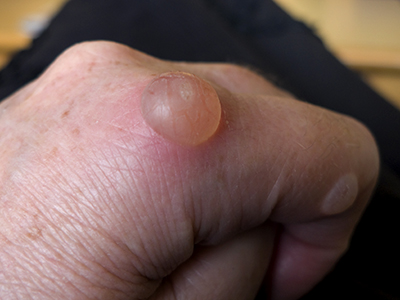
Research identifies a novel treatment for the most common autoimmune blistering diseases.
The Granzyme B (GzmB) enzyme has been identified as a driver of itchy and sometimes life-threatening pemphigoid diseases (PDs): autoimmune conditions that cause blistering and skin erosion that originate below the skin’s surface. New research led by Vancouver Coastal Health Research Institute (VCHRI) scientist Dr. David Granville has found that a gel containing a specific and potent inhibitor of GzmB activity, VTI-1002, resulted in significant skin improvements.
“Granzyme B is a destructive enzyme that accumulates in certain tissues as we age,” says Granville. “While we know that environmental factors that accelerate tissue aging, such as chronic smoking or sunlight exposure, can drive the production of this enzyme, the current study identifies its role in autoimmune blistering conditions that affect our most vulnerable populations.”

Common blisters—the separation of layers of skin and accumulation of fluid—are caused by friction or sunburn. In the case of PDs, blisters can spontaneously appear all over the body. These conditions can be very disfiguring and significantly reduce quality of life.
The most common autoimmune blistering disease, bullous pemphigoid, affects mainly the elderly, and may be associated with age-related neurologic conditions, as well as the use of newer psychotropic drugs, checkpoint inhibitors for cancer and dipeptidyl peptidase IV (DPP4i) inhibitors for diabetes.
“Blisters caused by these conditions can be extremely discomforting, unsightly and potentially fatal.”
“Given that there is currently no cure for pemphigoid diseases, the need for better treatments to care for affected individuals will continue to grow in the coming years as our population ages.”
Published in Nature Communications in January 2021, Granville’s study examined the topical application of the GzmB inhibitor VTI-1002 gel on skin affected by PDs.

GzmB is naturally produced by immune cells in the body and plays a role in helping to eliminate unwanted cells. However, in certain conditions, GzmB escapes from these cells into the extracellular space where it accumulates and eats away at structural proteins that hold the skin together.
In the case of PDs, GzmB accumulates in the blister fluid and surrounding tissues, cleaving key proteins that anchor the top layer of skin (epidermis) to the bottom layer (dermis), which leads to skin separation and blistering.

Research results also showed that the GzmB-inhibiting gel protected the structural integrity of the skin and reduced inflammation.
The growing burden of autoimmune blistering
The current treatment for PDs is topical or oral corticosteroids. Often associated with severe side effects and occasionally mortality, they also contribute to skin thinning and impaired healing, both of which are already problematic among elderly individuals. Treatments are therefore needed that do not exacerbate these conditions.
“While several studies have investigated how to target and block other enzymes that may lead to PDs, our Granzyme B-blocking VTI-1002 gel reduced both the inflammation and disruption of the skin layers that contribute to blistering,” notes Granville.
One reason for the effectiveness of blocking GzmB is that, unlike other proteases—enzymes that can break down proteins in the body—there are no inhibitors to prevent GzmB activity outside of cells, Granville explains. So when GzmB accumulates over time due to chronic inflammation, the body lacks a natural defense mechanism to rein it in.
“Our study results show great promise for GzmB inhibition,” says Granville. “A GzmB-blocking gel could be used as a safer, more targeted alternative for treating autoimmune blistering and other inflammatory skin diseases.”


